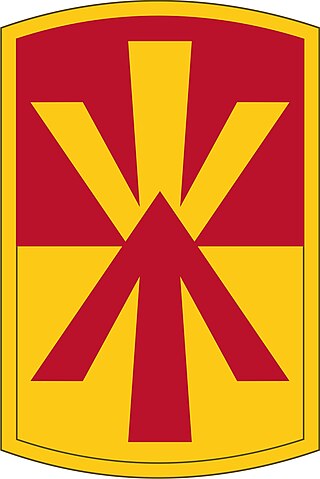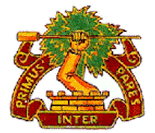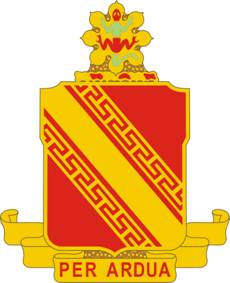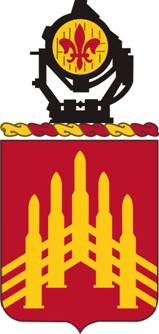The 60th Air Defense Artillery Regiment is an air defense unit of the United States Army.

The 4th Air Defense Artillery Regiment was constituted 1 June 1821 in the Regular Army as the 4th Regiment of Artillery and organized from new and existing units with headquarters at Pensacola, Florida. As a result of the division of the Artillery Corps into Coast and Field Artillery units, the Regiment was broken up 13 February 1901, and its elements reorganized and redesignated as separate numbered companies and batteries of the Artillery Corps.

The 75th Field Artillery Brigade is an artillery brigade in the United States Army. It is currently based in Fort Sill, Oklahoma and supports the III Armored Corps. The brigade is officially tasked to train and prepares for combat; on orders deploys to any area of operations to plan, synchronize and execute combined, and joint fires and effects. Integrate attached ground and air maneuver forces and on order function as a maneuver headquarters in support of full spectrum operations.
The 258th Field Artillery Regiment or "Washington Greys" is a field artillery unit of the New York Army National Guard that traces its lineage from 1809 to present. Circa 1957–1966 it consisted of four battalions.

The 11th Air Defense Artillery Brigade is an air defense artillery brigade of the United States Army stationed at Fort Bliss.

The 69th Air Defense Artillery Brigade is an air defense artillery brigade of the United States Army.

The 1st Air Defense Artillery is an air defense artillery regiment in the United States Army first formed as a field artillery unit in 1821.

The 52nd Air Defense Artillery Regiment is an air defense artillery regiment of the United States Army first organized in 1917 as a railway gun unit. It continued in that role unit 1943, when the regiment was broken in separate railway gun battalions, and in the following year the units were reorganized and redesignated as field artillery.

The 2nd Air Defense Artillery Regiment is an air defense artillery regiment of the United States Army, first formed in 1821 as a field artillery unit.

The 5th Air Defense Artillery Regiment is an Air Defense Artillery regiment of the United States Army, first formed in 1861 in the Regular Army as the 5th Regiment of Artillery.

The 3rd Air Defense Artillery Regiment is an air defense artillery regiment of the United States Army, first formed in 1821 as the 3rd Regiment of Artillery.

The 7th Air Defense Artillery Regiment is an air defense artillery regiment of the United States Army, first constituted in the Regular Army as the 7th Regiment of Artillery on 8 March 1898. The 6th and 7th U.S. Artillery Regiments were constituted on 8 March 1898, three weeks after the explosion of USS Maine in Havana, Cuba on 15 February 1898, as the United States' declaration of war on Spain and commencement of the Spanish–American War seemed imminent.

The 44th Air Defense Artillery Regiment is an Air Defense Artillery regiment of the United States Army, first constituted in 1918 in the Regular Army during World War I. During World War II the unit served as the 54th Coast Artillery Regiment

The 6th Air Defense Artillery Regiment is an air defense artillery regiment in the United States Army, first formed in 1898 as the 6th Regiment of Artillery. The 6th and 7th U.S. Artillery Regiments were constituted on 8 March 1898, three weeks after the explosion of the USS Maine in Havana, Cuba on 15 February 1898, as the United States' declaration of war on Spain and commencement of the Spanish–American War seemed imminent.

The 71st Air Defense Artillery was a regiment in the United States Army.
The 61st Air Defense Artillery Regiment is an air defense artillery regiment in the United States Army. The lineages of some of the units that initially made up the 61st Artillery (CAC) give the regiment's 1st Battalion campaign credit for the War of 1812.
The 62nd Air Defense Artillery Regiment is an Air Defense Artillery regiment in the United States Army. The lineages of some of the units that have been part of the 62nd Air Defense Artillery and its predecessors give the regiment campaign credit for the War of 1812.
The 251st Coast Artillery was a coast artillery regiment in the California National Guard, constituted in 1924 as a harbor defense regiment for the 9th Artillery District and re-designated in 1930 as an antiaircraft regiment. It served in World War II in that capacity.
The 562nd Air Defense Artillery Regiment was an air defense regiment of the United States Army. It was organized under the Combat Arms Regimental System.

The 265th Air Defense Artillery Regiment is an air defense artillery regiment in the Florida Army National Guard. The unit was formed 19 October 1923 in the Florida National Guard as the 1st Separate Battalion, Coast Artillery Corps. It was reorganized and redesignated as the 265th Coast Artillery Regiment (CA) (HD) in 1929. The 265th was activated for World War II and served in the harbor defenses of Galveston, Texas, Los Angeles, California, Key West, Florida, Sandy Hook, New Jersey, and Alaska until broken up into battalions in July 1944. The unit lineage was carried by two antiaircraft battalions organized in 1946, one of which was federalized in Florida during the Korean War. Consolidated with other units in 1959 as the 265th Artillery; reorganized in 1987 as the 265th Air Defense Artillery.
















